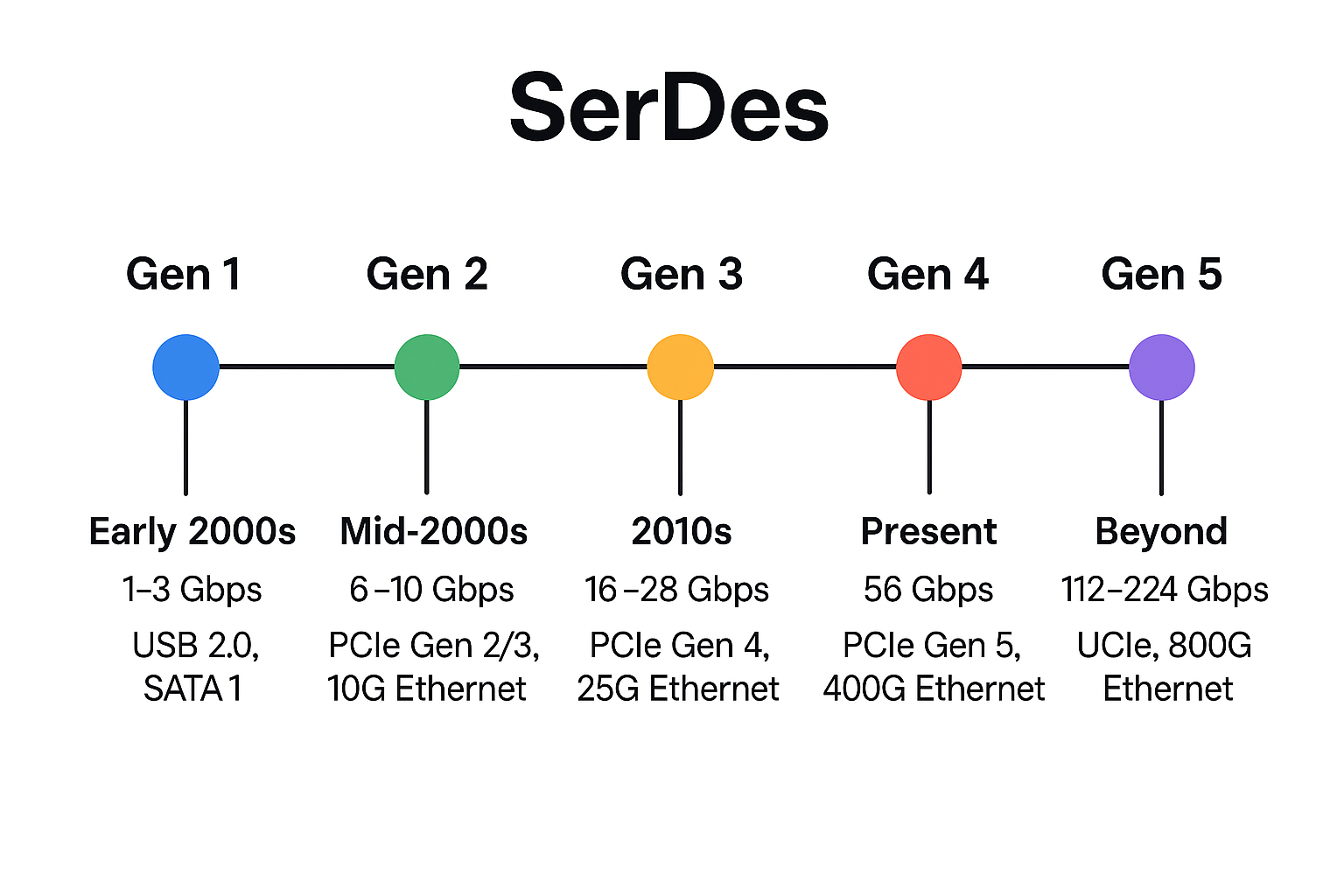Overview
SerDes (short for Serializer/Deserializer) is a high-speed circuit block used to convert parallel data to serial form and back again. It is widely used in integrated circuits, networking equipment, SoCs, and interconnect protocols to enable high-bandwidth data transmission over limited pin or channel resources.
SerDes technology is foundational to modern high-speed interfaces such as PCI Express (PCIe), Ethernet, USB, SATA, DisplayPort, JESD204, and chiplet interconnects (e.g., UCIe, BoW).
🔧 Purpose and Functionality
A SerDes system includes two main components:
-
Serializer – Converts wide parallel data into a narrow high-speed serial stream.
-
Deserializer – Converts the serial stream back into parallel data at the receiver end.
Why SerDes is Important:
-
Reduces the number of required I/O pins and wires.
-
Minimizes signal skew and routing complexity.
-
Enables transmission over high-speed links with low power.
🏗️ SerDes Architectures
1. Parallel SerDes (Simplex)
-
Used for unidirectional communication.
-
Example: HDMI transmitter.
2. Full Duplex SerDes
-
Supports simultaneous transmit and receive.
-
Used in most high-speed network interfaces (Ethernet, PCIe).
3. Source-Synchronous SerDes
-
Clock transmitted alongside data (e.g., DDR, older SerDes).
4. Clock-Embedded SerDes (Clock Recovery)
-
Receiver extracts clock from serial stream using CDR (Clock and Data Recovery).
-
Used in PCIe, USB, Ethernet, etc.
⚙️ Key SerDes Parameters
| Parameter | Description |
|---|---|
| Data Rate | Speed of transmission (e.g., 10 Gbps, 112 Gbps) |
| Latency | Delay introduced by serialization and deserialization |
| Jitter | Timing variation in signal transitions |
| Bit Error Rate (BER) | Ratio of error bits to total transmitted |
| Pre-emphasis / Equalization | Signal conditioning to maintain eye opening at receiver |
| CDR (Clock & Data Recovery) | Enables receiver to align sampling with incoming data |
🧠 SerDes in Protocols
| Protocol | SerDes Role |
|---|---|
| PCIe Gen 1–6 | Uses SerDes for bidirectional high-speed lanes |
| Ethernet (10G/25G/100G/400G) | Uses SerDes-based physical layer (PHY) for optical/copper links |
| SATA/SAS | Serial data transport for storage |
| USB 3.x/4 | Uses SerDes with Type-C connector and DP Alt mode |
| DisplayPort, HDMI | Multimedia SerDes transmission |
| JESD204B/C | High-speed serial links between ADCs/DACs and FPGAs/SoCs |
| UCIe, BoW, XSR, AIB | SerDes-based chiplet interconnect standards |
🛠️ Design Considerations
On-Die vs. PHY IP
-
SerDes can be integrated as custom hard IP blocks in ASIC/SoC designs.
-
Leading SerDes IP vendors provide:
-
Full custom PHYs (Analog + DSP)
-
Multi-rate support
-
Process-portable options (from 28nm to 3nm and below)
-
Power vs. Performance Tradeoff
-
High-speed SerDes consume significant power.
-
Low-power SerDes variants are critical for mobile, edge, and AI applications.
📈 Evolution and Generations
| Generation | Data Rate | Application |
|---|---|---|
| Gen 1 (early 2000s) | 1–3 Gbps | USB 2.0, SATA 1 |
| Gen 2 (mid-2000s) | 6–10 Gbps | PCIe Gen 2/3, 10G Ethernet |
| Gen 3 | 16–28 Gbps | PCIe Gen 4, 25G Ethernet, JESD204B |
| Gen 4 | 56 Gbps | PCIe Gen 5, 100G Ethernet, SerDes for AI |
| Gen 5 (current) | 112 Gbps | PCIe Gen 6, 400G/800G Ethernet |
| Gen 6 (in development) | 224 Gbps | UCIe 2.0, 1.6Tbps Ethernet, future chiplet links |
🌐 Key SerDes IP Vendors
| Company | Notes |
|---|---|
| Synopsys | Industry leader in PHY IP for PCIe, Ethernet, USB, UCIe |
| Alphawave Semi | Specializes in 56G/112G SerDes for AI/HPC/datacenter |
| Cadence | Offers SerDes IP and PHYs (USB4, PCIe, 112G) |
| Rambus | High-speed memory and SerDes PHY IP |
| Credo, eSilicon (Inphi) | Optical SerDes PHY IP, CPO |
| Siemens EDA | Offers simulation and verification of SerDes systems |
| AnalogX, Kandou, Marvell | Focused on ultra-low-power or chiplet-centric SerDes designs |
🔬 Applications
-
AI/ML Accelerators: SerDes enables chiplet-to-chiplet and die-to-die connections.
-
Automotive Ethernet: High-speed serial links in ADAS and infotainment.
-
5G Infrastructure: Baseband and fronthaul/backhaul transport via SerDes.
-
Datacenter Networking: 400G and 800G Ethernet switch-to-server links.
-
Consumer Electronics: Display (DP, HDMI), USB, storage, and camera interfaces.
🧭 Future Trends
| Trend | Impact |
|---|---|
| Chiplet architectures | High-bandwidth, low-power SerDes IP required |
| 112G–224G SerDes | Enabling terabit-scale networking |
| Co-Packaged Optics (CPO) | SerDes to optical transceiver integration |
| Die-to-Die PHYs | Short-reach, ultra-efficient SerDes for 3D ICs |
| AI-optimized DSP | Adaptive equalization and channel learning in real time |















Quantum Advantage is About the Algorithm, not the Computer